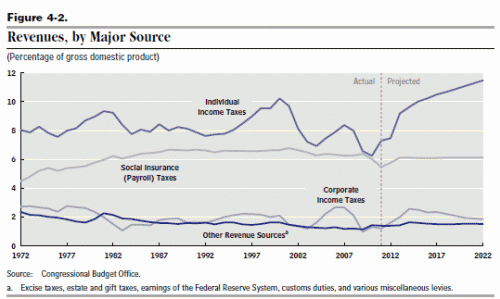There are three key frames that are needed to best think about tax reform: math, fairness and economic growth.
First math. Tax receipts must go up if we are ever going to have another balanced budget. There is some consensus that a tax reform that “broadens the base and lowers the rate” is the way to achieve this, and I agree. However, it is important to understand that we must have a net tax increase across all federal tax sources, or we won’t have a balanced budget ever again given any plausible spending scenario. The first frame for tax reform is math.
Second, the components of federal tax receipts could be changed, which raises the key issues of fairness and economic growth. In making trade-offs between these two values, it is useful here to recall the historical share of different sources of federal tax revenue (personal income and payroll taxes, corporate taxes, and all other taxes including excise and estate taxes). From the CBO’s latest report (p. 81):
Corporate taxes have been a relatively small proportion of total federal tax receipts for 30 years (~10-13% of total receipts) while income and payroll taxes have been much larger sources of federal receipts with income taxes being the more volatile of the two. Excise and estate taxes have been small and declining (note: these shares would be very different in 1950, with corporate and excise taxes much larger).
The projected increase in income taxes as a percent of GDP shown in the figure after 2012 is simply the tax code reverting to pre-2001 levels on January 1, 2013, and the dip in payroll taxes and subsequent increase in 2012 is the enactment of the payroll tax cut in 2011 and the sun-setting of same (above it is shown as ending on February 29, 2012 as is current law).
A great deal of discussion of the tax code and tax reform has focused on fairness, which is a key concept, but fairness needs to be anchored to a bottom line percent of GDP to be collected in taxes (the Fiscal Commission suggests 21% of GDP). Once a target percent of GDP to be collected in taxes is set, fairness must be discussed along side the impact of the tax code on economic growth (higher growth is better for the deficit and for jobs). If we are going to develop a plan that can produce a sustainable budget, all three of the following frames must be an explicit part of the tax reform discussion.
- math
- fairness
- economic growth
The bottom line for tax reform if you want a sustainable budget is how will federal tax receipts be increased, not if.
DT

